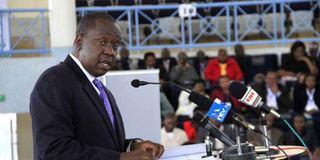Universities facing serious financial crisis

Fred Matiang'i, the Cabinet Secretary for the Ministry of Education, Science and Technology, speaks at Kenyatta University in Nairobi during the first biennial conference on the state of higher education on August 22, 2016. PHOTO | DIANA NGILA | NATION MEDIA GROUP
What you need to know:
- The worst-affected are private universities.
- It is emerging that many of them are increasingly finding it difficult to operate.
Kenya’s universities are facing a serious financial crisis, operating on a Sh9 billion deficit, which undermines their ability to offer quality education and training and conduct research.
The worst-affected are private universities that depend on students’ fees for their upkeep – they are indebted to the tune of Sh7 billion. The country has 33 public universities and 35 private universities, out of which 17 are fully chartered.
With such huge deficits, it is emerging that many private universities are increasingly finding it difficult to operate, with some on the verge of folding up.
“The university sub-sector is spending more resources than what it receives from the various income streams. If this trend is not remedied then the universities may not meet their obligations as mandated in law,” says a new report by the Commission for University Education.
The State of University Education in Kenya report, which was published by the Commission for University Education, was launched last Monday by Fred Matiang’i, the Cabinet Secretary for Education, Science and Technology, during the inaugural higher education conference held at Kenyatta University. The report is based on data collected from the universities between September 2015 and March this year.
STAFF COSTS
In a four-year financial tracker, the report says the universities received a total of Sh345.9 billion between 2010-2014 but spent the bulk on staff costs, leaving minimal for tuition, capital development and research. It notes that public universities continued to benefit substantially from State capitation that constituted about 50 per cent of their incomes.
The financial crisis has serious implications on the universities, among others, stifling growth, delivery of poor services, exodus of academic staff seeking better pay elsewhere, student riots, and stunted creativity and innovation. Some universities resort to unethical practices to attract students like lowering entry requirements and relaxing academic standards to graduate many students. Others mount the supposedly marketable courses and leave out others and, hence, limit students’ choices.
Indeed, evidence in the report shows that business and administration courses have recorded the highest students’ enrolment.
In absolute terms, there were 120,223 students enrolled in business-related courses in the universities, comprising 22 per cent of the population, followed by education (arts) which had 79,368 students and social sciences, 46,139. Contrastingly, just 1,148 students were studying veterinary science, 2,293 manufacturing and 5,057, architecture. Overall, the universities had a total enrolment of 539,749 students in 2014/15 academic year.
High enrolment in business-related courses is driven by the perception that they offer higher chances of employment. Inversely, the same perception has fired universities to mount the courses to attract more students and rake in fees. More than 50 out of the 68 universities offer business courses.
SOCIAL SCIENCES
For education (arts) as well as social sciences and humanities, the enrolments are by default. Most of the students are admitted arbitrarily, especially under regular programmes at the public universities, where they are offered to anyone who does not qualify for the top-notch professional courses. These courses also attract teachers without degree qualifications who seek to upgrade their skills and prime themselves for promotion.
Broadly, the report indicates several worrying trends in university education. First, there are growing imbalances in regard to disciplines. About 80 per cent were enrolled for humanities and social sciences but just about 20 per cent were in science, engineering and technology. The implication is that graduates of some of the courses have flooded the labour market, while other professions are suffering.
Second, the number and quality of university lecturers is disquieting. Evidence is presented of universities and courses without professors, among them, veterinary science, journalism, law, manufacturing and architecture. Private universities and the newly-established public university colleges and campuses are the worst-hit.
Universities have bachelor’s holders in their academic staff. At least, some 1,365 lecturers have a bachelor’s degree and another 656 have diplomas contrary to the requirement that a university lecturer should have a minimum of a master’s degree and even then, such faculties are expected to work as graduate assistants, operating under the tutelage of professors and PhD holders. Third, the report highlights inequalities in terms of gender and physical abilities.
So far, females constitute 41 per cent of undergraduate students compared to 49 per cent males; but the number thins out as one goes up the ladder, with females constituting just 30 per cent of those enrolled for PhD programmes. Matters are worse at the level of academic staff, where in public universities, females represent just 30 per cent.




